Exhibition dates: 30th September – 21st December 2019, posted December 2020
Installation view of the exhibition Cy Twombly: Sculpture at Gagosian, London
Photo: Marcus Bunyan
Recovered time
For my friend and mentor Ian Lobb, who is a Twombly aficionado. I posted him back three Twombly posters from the pop up shop…
“Twombly made his sculptures from found materials such as plaster, wood, and iron, as well as objects that he habitually used and handled in the studio. Often modest in scale, they embody his artistic language of handwritten glyphs and symbols, evoking narratives from antiquity and fragments of literature and poetry.”
“This thought, that within each piece there is an underlying poetry, an underlying history, to be uncovered, elucidates the potential within each sculpture.”
A Time To Remain, A Time To Go Away.
Marcus
All iPhone images © Marcus Bunyan. Please click on the photographs for a larger version of the image.
“I would like to think in the sculptures there is a tendency towards the fundamental principle in Homer’s world. That poetry belongs to the defeated and to the dead.”
“White paint is my marble.”
Cy Twombly
Installation views of the exhibition Cy Twombly: Sculpture at Gagosian, London
Photos: Marcus Bunyan
Gagosian is pleased to present an exhibition of Cy Twombly’s sculptures, in association with the Cy Twombly Foundation. The exhibition marks the publication of the second volume of the catalogue raisonné of sculptures, edited by Nicola Del Roscio, President of the Cy Twombly Foundation, and published by Schirmer/Mosel.
Twombly made his sculptures from found materials such as plaster, wood, and iron, as well as objects that he habitually used and handled in the studio. From 1946 onward, he created many assemblages, though they were rarely exhibited before the 1997 publication of the first volume of his catalogue raisonné. Often modest in scale, they embody his artistic language of handwritten glyphs and symbols, evoking narratives from antiquity and fragments of literature and poetry.
Many of Twombly’s sculptures are coated in white paint, which unifies and neutralises the assembled materials and renders the newly formed object into a coherent whole. In referring to white paint as his “marble,” Twombly recalls traditions of Egyptian, Greek, and Roman sculpture while also subverting marble’s classical connotation of perfection through his roughly painted surfaces. The intimate scale of these works, together with their textural coats of paint, underscores their fundamentally haptic nature.
Some of Twombly’s sculptures allude to architecture, geometry, and Egyptian and Mesopotamian statuary, as in the rectangular pedestals and circular structures of Untitled (1977) and Chariot of Triumph (1990-98). Untitled (In Memory of Álvaro de Campos) (2002) comprises a rounded wooden trough stacked with a rectangular box, an elongated mound, and a vertical wooden board – all accumulating into a form that resembles a headstone or cenotaph. Thickly daubed in white, the sculpture bears the titular inscription scrawled in the graffiti-like hand so typical of Twombly’s drawings and paintings, and below it, the words “to feel all things in all ways.” Drawn from a poem by Álvaro de Campos (one of Portuguese poet Fernando Pessoa’s pseudonyms), the inscription suggests the legibility of the sculpture itself, and positions the three-dimensional object as a surface to be worked on.
In 1979, Twombly began casting some of his assemblages in bronze. The first iteration of Untitled (2002), on view in this exhibition, was made in 1955, soon after his return to New York from Europe and North Africa. Like other works from this period, this sculpture makes reference to the ancient artefacts the artist encountered in his travels. Consisting of bundled sticks, it evokes an object of private devotion or fetish. By casting this work in bronze in 2002, Twombly literally and figuratively substantiated the small sculpture into something like an archeological treasure recovered from the past.
A fully illustrated catalogue will accompany this exhibition.
Press release from the Gagosian website [Online] Cited 08/11/2020
Twombly made his sculptures from found materials such as plaster, wood, and iron, as well as objects that he habitually used and handled in the studio. Often modest in scale, they embody his artistic language of handwritten glyphs and symbols, evoking narratives from antiquity and fragments of literature and poetry.
Cy Twombly (American, 1928-2011)
Untitled (To Apollinaire) (installation view)
2009
Painted bronze
Photo: Marcus Bunyan
Cy Twombly (American, 1928-2011)
Untitled (To Apollinaire) (installation view)
2009
Painted bronze
Photo: Marcus Bunyan
Cy Twombly (American, 1928-2011)
Humul (installation view)
1986
Painted bronze
Photo: Marcus Bunyan
Cy Twombly (American, 1928-2011)
Untitled (installation view)
2004
Bronze, edition 4/6
31 7/8 × 15 1/4 × 11 5/8 inches (81 × 38.5 × 29.5cm)
Photo: Marcus Bunyan
Cy Twombly (American, 1928-2011)
Untitled (In Memory Of Babur) (installation view)
2009
Bronze
Photo: Marcus Bunyan
Babur (14 February 1483 – 26 December 1530), born Zahīr ud-Dīn Muhammad, was the founder of the Mughal Empire and first Emperor of the Mughal dynasty (r. 1526-1530) in the Indian subcontinent. He was a descendant of Timur and Genghis Khan through his father and mother respectively.
Cy Twombly (American, 1928-2011)
Turkish Delight (installation view)
2000
Wood, plaster, acrylic, and brass
45 1/2 × 18 × 16 1/2 inches (115.6 × 45.7 × 41.9cm)
Photo: Marcus Bunyan
Installation view of the exhibition Cy Twombly: Sculpture at Gagosian, London showing from left to right, Herat (1998) and Batrachomyomachia (1998)
Photo: Marcus Bunyan
Cy Twombly (American, 1928-2011)
Herat (installation view)
1998
Painted bronze
Photo: Marcus Bunyan
Herāt is the third-largest city of Afghanistan.
Cy Twombly (American, 1928-2011)
Batrachomyomachia (installation view)
1998
Painted bronze
Photo: Marcus Bunyan
The Batrachomyomachia or Battle of the Frogs and Mice is a comic epic, or a parody of the Iliad, commonly attributed to Homer, although other authors have been proposed.
Cy Twombly (American, 1928-2011)
Untitled (installation view)
1998
Painted bronze
Photo: Marcus Bunyan
Cy Twombly (American, 1928-2011)
A Time To Remain, A Time To Go Away (installation view)
1998-2001
Painted bronze
Photo: Marcus Bunyan
Cy Twombly (American, 1928-2011)
A Time To Remain, A Time To Go Away (installation view detail)
1998-2001
Painted bronze
Photo: Marcus Bunyan
Cy Twombly (American, 1928-2011)
Untitled (AOEDE) (installation view)
Nd
Photo: Marcus Bunyan
Cy Twombly (American, 1928-2011)
Untitled (AOEDE) (installation view detail)
Nd
Photo: Marcus Bunyan
Aoede
In Greek mythology, Aoede was one of the three original Boeotian muses, which later grew to five before the Nine Olympian Muses were named. Her sisters were Melete and Mneme. She was the muse of voice and song. According to Greek mythology, she is the daughter of Zeus, the King of the Gods, and Mnemosyne, the goddess of memory.
She lends her name to the moon Jupiter XLI, also called Aoede, which orbits the planet Jupiter.
Text from the Wikipedia website
Installation view of the exhibition Cy Twombly: Sculpture at Gagosian, London
Photo: Marcus Bunyan
Cy Twombly (American, 1928-2011)
Chariot of Triumph (installation view)
1990-98
Wood, paint, cloth, and nails
42 1/2 × 20 7/8 × 74 3/8 inches (108 × 53 × 189cm)
Photo: Marcus Bunyan
Cy Twombly (American, 1928-2011)
Untitled (installation view)
2005
Photo: Marcus Bunyan
Cy Twombly (American, 1928-2011)
Untitled (installation view)
2005
Photo: Marcus Bunyan
Cy Twombly (American, 1928-2011)
Untitled
2009
Bronze, edition 2/3
94 3/4 × 15 7/8 × 12 3/8 inches (240.4 × 40.3 × 31.5cm)
Photo: Marcus Bunyan
Cy Twombly (American, 1928-2011)
Untitled (installation view detail)
2009
Bronze, edition 2/3
94 3/4 × 15 7/8 × 12 3/8 inches (240.4 × 40.3 × 31.5cm)
Photo: Marcus Bunyan
Cy Twombly Shop
Gagosian is pleased to announce a pop-up shop devoted to Cy Twombly at Gagosian, Davies Street, London, to open on the occasion of the exhibition Cy Twombly: Sculpture at Gagosian, Grosvenor Hill, London.
The shop will celebrate the newly published Cy Twombly: Catalogue Raisonne of the Sculpture, vol. 2, 1998-2011, and Cy Twombly: Homes & Studios, both from Schirmer / Mosel, and will feature an extensive selection of historically important reference books on the artist. Rare ephemera from many of Twombly’s exhibitions in Italy from the 1960s will also be included, alongside vintage and contemporary posters and a selection of prints and photographs by the artist.
Text from the Gagosian website [Online] Cited 08/11/2020
Cy Twombly Shop
Photo: Marcus Bunyan
Cy Twombly Shop
Photo: Marcus Bunyan
Cy Twombly Shop interior showing posters
Photo: Marcus Bunyan
Heiner Bastian (ed.,). Cy Twombly: The Printed Graphic Work Catalogue Raisonné 2017 book cover
Along with his celebrated drawings, paintings, sculptures, and photographs, Cy Twombly has left an imposing body of graphic work as well. As early as 1984, the Berlin-based art writer and Twombly expert, Heiner Bastian, compiled the first catalogue raisonné of the artist’s printed graphics which has been out of print for 18 years. Now back in print for the first time, this new edition of the catalogue raisonné has been updated and includes the graphic works Twombly created since 1984 until his death in 2011.
Cy Twombly’s graphic oeuvre is characterised by a variety of graphic and printing techniques. Along with monotypes, etchings, lithographs, and silkscreens, the artist tested his expertise using offset lithographs and the combination of various print and reproduction techniques.
Cy Twombly: Camino Real 2010 catalogue front cover
Published in 2010, on the occasion of the exhibition “Cy Twombly: Camino Real” at Gagosian Gallery Paris
Text by Marie-Laure Bernadac
10 7/8 x 13 1/2 inches (27.6 x 34.3cm); 32 pages; Fully illustrated
Designed by Graphic Thought Facility, London; Printed by Shapco Printing, Minneapolis, MN
Carlos Basualdo. Cy Twombly: Fifty Days at Iliam, 2018 book cover.
This revelatory publication provides a comprehensive and multifaceted account of Cy Twombly’s masterpiece Fifty Days at Iliam (1978), a series of ten paintings based on Alexander Pope’s 18th-century translation of Homer’s Iliad. Essays by a team of both art historians and scholars of Greco-Roman studies explore topics including the paintings’ literary and cultural references to antiquity and Twombly’s broader engagement with the theme of the Trojan War, which first appeared in his work in the early 1960s and was a subject to which he would return throughout his career. Firsthand accounts of the artist at work complement the essays. Images of the canvases and related drawings and sculptures are joined by previously unpublished photographs showing Fifty Days at Iliam in the artist’s studio at the time of their completion.
Eva Keller and Heiner Bastian. Audible Silence: Cy Twombly at Daros 2002
Cy Twombly
Gaeta Sets
1987
Hine Editions
28.2 x 23.8cm (11.1 x 9.4 in.)
Colour photolithographs throughout. (4to) original cream wrappers, slipcase. One of 1500 copies
Installation views of the Cy Twombly Shop at Gagosian, London
Photos: Marcus Bunyan
Edmund De Waal. Cy Twombly – Photographs. Gagosian Gallery, 2012 and Mary Jacobus. Cy Twombly – Photographs Volume II. Gagosian Gallery, 2015 book covers
Cy Twombly. Fotografie di Gaeta. Published by Fondazione Nicola Del Roscio, 2014.
Published on the occasion of the exhibition Cy Twombly. Fotografie di Gaeta on view at the Museo Diocesano, Gaeta (July 5 – September 28, 2014)
Vincent Katz. Cy Twombly: Photographs 1951-1999. Schirmer Mosel, 2004.
This world premiere is an aesthetic sensation. Since his student days in the early 50s, American painter and sculptor Cy Twombly, one of the greatest artists alive today, has concerned himself with photography. In this volume, he presents his photographic work of 50 years to the public for the first time ever. Taking up 19th-century Pictorialist traditions, Twombly’s photographs are, just like his paintings, drawings and sculptures, documents of a profound personal poetry. Studio shots, details of his own statuary, sculptures from his collection, romantic landscapes, flowers, and portraits of friends constitute the cosmos of his photographic oeuvre. Printed with matte colours on matte paper, a special “dryprint” process lends these images a velvety, porous, almost grainy quality. On the stage of today’s art, they touch long-lost chords. Resonant of the concepts of fin de siècle art they are, yet, thoroughly contemporary in their minimalism, creating an aesthetic vision by the commonest means.
Laszlo Glozer. Cy Twombly: Photographs 1951-2007. Schirmer Mosel, 2008.
Ever since his student days, Cy Twombly has concerned himself with photography, but only in recent years has he turned it into a unique artistic concept – and an aesthetic sensation. Twombly’s photographic pieces are documents of a fascinatingly enigmatic and personal poetry. His studios in Lexington and Gaeta, details of his own sculptures and collected sculptural items, landscape motifs, fruits and flowers appear in a mysteriously transformed manner on these delicate sheets. Printed in matte colours on matte paper using a dry-print process that imbues them with velvet and an almost grainy hue, the images are vaguely reminiscent of the pictorialist tradition in fin de siecle photography. In their minimalist way, however, generating aesthetic visions by the simplest of means, they are utterly contemporary. Photographs 1951-2007 presents Twombly’s photographic works of over fifty years- full of surprises and breathtaking beauty.
Hubertus von Amelunxen. Cy Twombly: Photographs 1951-2010. Schirmer Mosel, 2011.
Cy Twombly’s photographs are a late revelation. The painter, world-famous for his scribbled abstract paintings and his nervous drawings, has been a prolific photographer from his early student days. In this late stage of his career, he unveils his poetic treasures step by step. The new volume Photographs III brings together early works and combines them with flower studies and studio interiors. Most interesting are Twombly’s photographic studies on his own paintings and sculptures, casting a special light on the interpretation of these works. The book features some 130 hitherto unpublished photographs. It accompanies an exhibition that starts off in Munich in 2011 and will then travel through Europe. With an essay by art and photo historian Hubertus Von Amelunxen.
Achim Hochdörfer. Cy Twombly Vol. IV: Unpublished Photographs 1951-2011. Schirmer Mosel, 2013.
As his final creative surprise, Cy Twombly, one of the greatest 20th-century artists, has given to the world a huge body of photographic works emphasising his unique artistic vision. Contrary to his sharp and teeming drawings his photographs are not sharp at all. They are colourful, soft, and warm and generate a painterly impression. Their colouring is as unique as their fine sense of composition. The photographs reveal the artist’s vision embedded both in the world of objects and the nature that surrounds him. His own artistic creations and collection of art objects in his various homes are a favourite subject of his photographic studies. Twombly’s photographic work offers a new dimension for understanding the artist’s paintings, drawings, and sculptures. The new book features some 120 photographic prints from the Cy Twombly Estate in Gaeta, most of them previously unpublished.
Nicholas Cullinan et al. Le Temps Retrouvé: Cy Twombly photographe & artistes invites. Collection Lambert en Avignon musée d’art contemporain. Actes Sud, 2012.
Although world-famous for his paintings and sculptures, Cy Twombly (1928-2011) was also a photographer, and his practice of photographing interiors, the sea and still lifes, as well as his paintings and sculptures, spanned the duration of his 60-year career. This massive two-volume catalogue gathers this lesser-known aspect of the artist’s output, contextualising it through an exhibition that Twombly himself curated at the Collection Lambert in Avignon. His selection of works was both original and revealing: Jacques Henri Lartigue’s albums, the marine horizons of Hiroshi Sugimoto, the serial photographs of Ed Ruscha and Sol Lewitt, and the portraits of Diane Arbus and his close friend Sally Mann. With this publication, Twombly also draws a direct lineage between himself and earlier photographer-artists such as Édouard Vuillard and Edgar Degas (a lineage that provides this catalogue’s Proustian subtitle). The two volumes are held together with a blue printed ribbon.
Gagosian
20 Grosvenor Hill
London w1k 3qd
Phone: +44 20 7495 1500
Opening hours:
Tuesday – Saturday 10 – 6 by appointment only

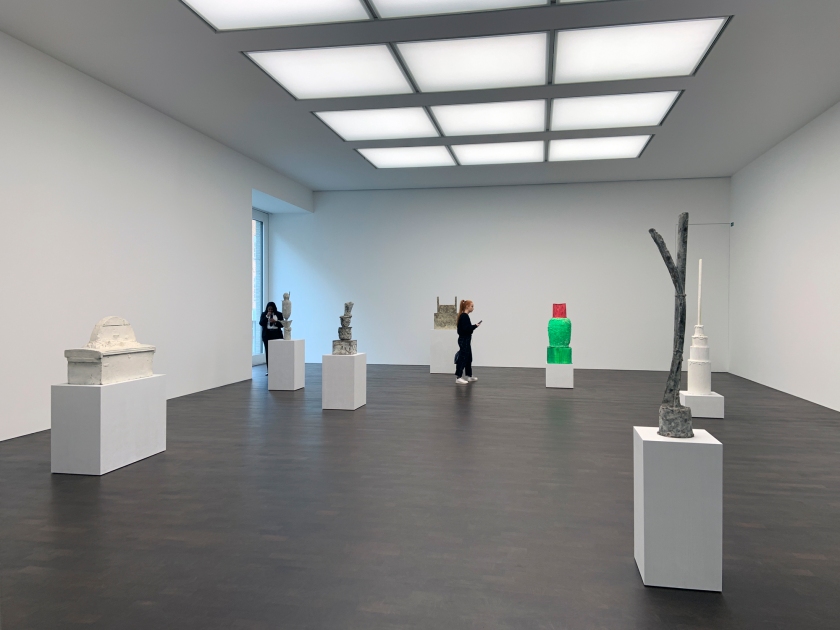

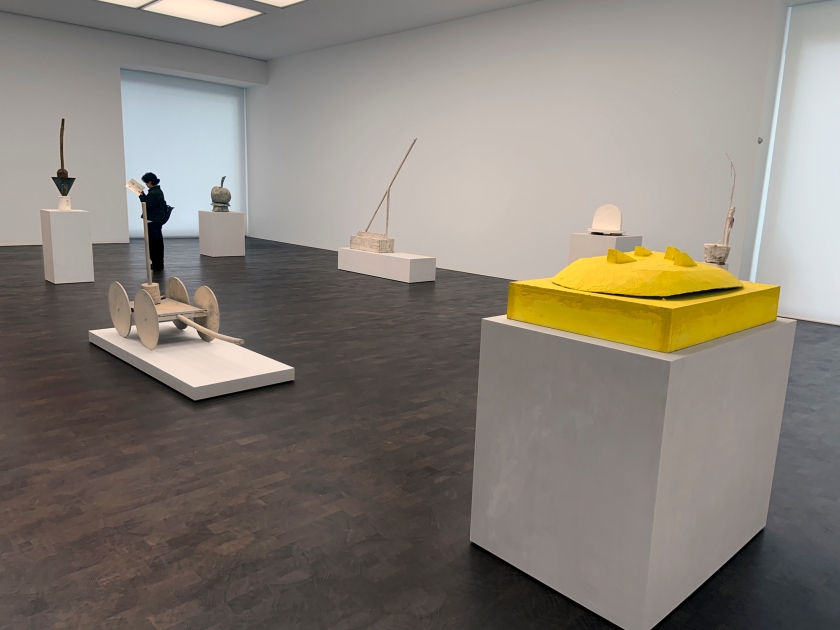
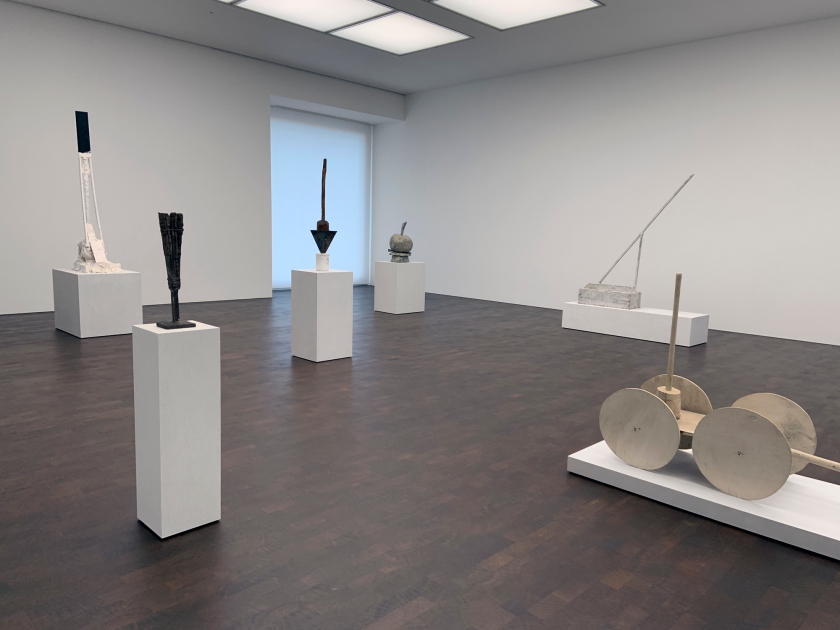



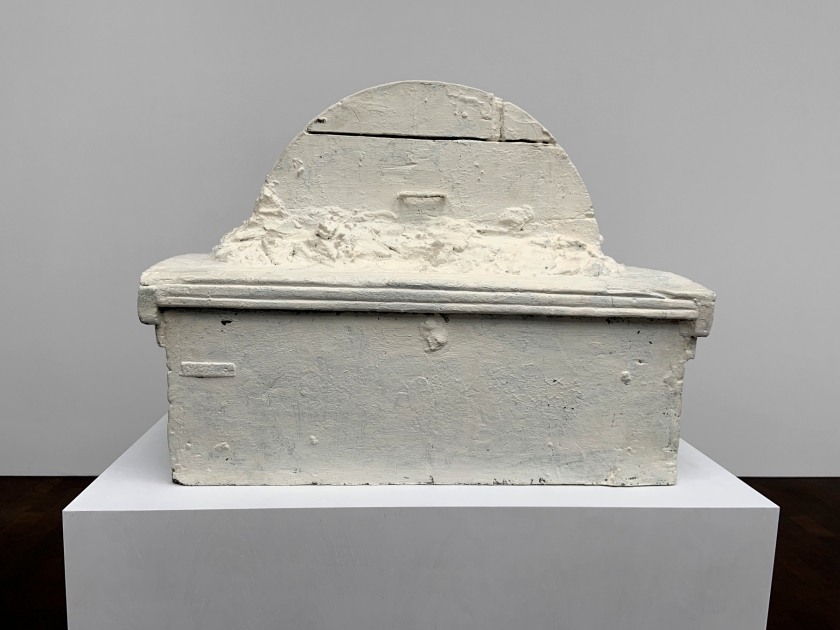



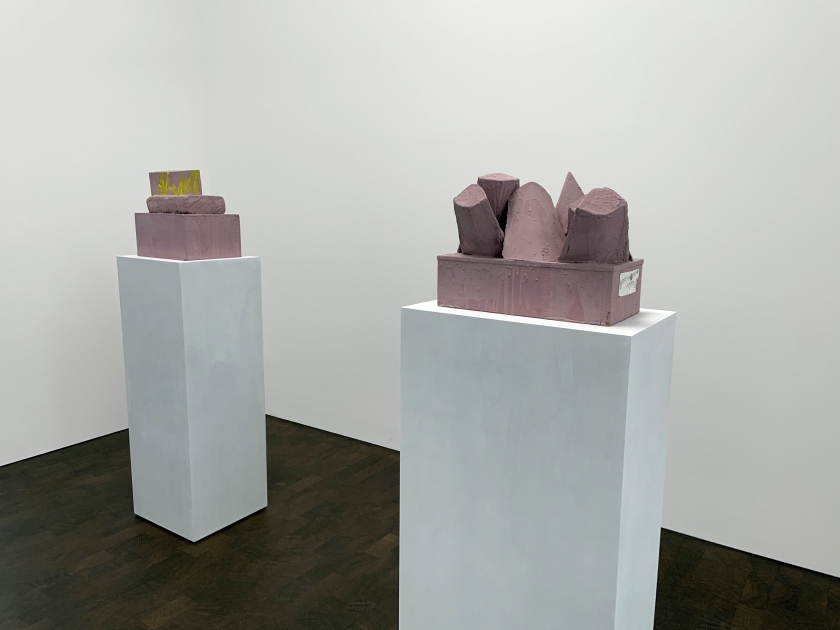

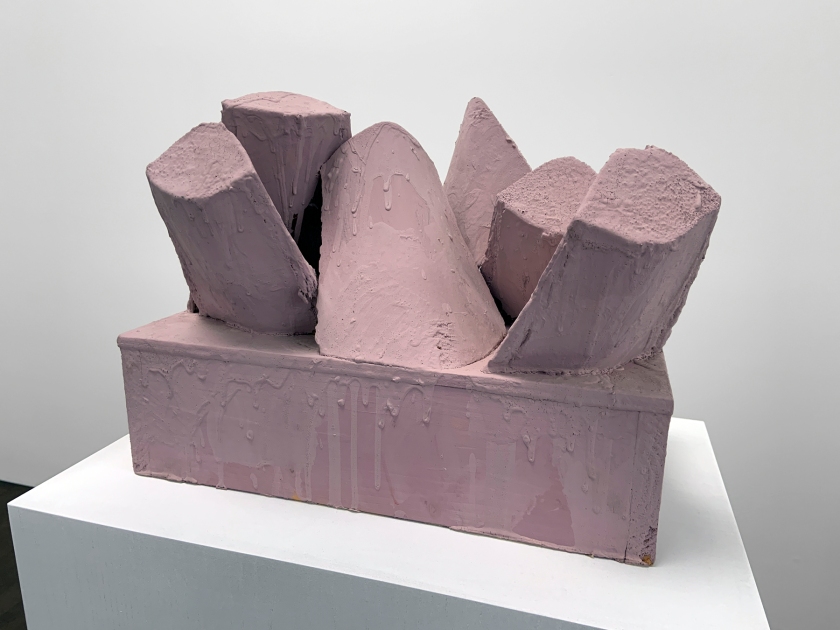





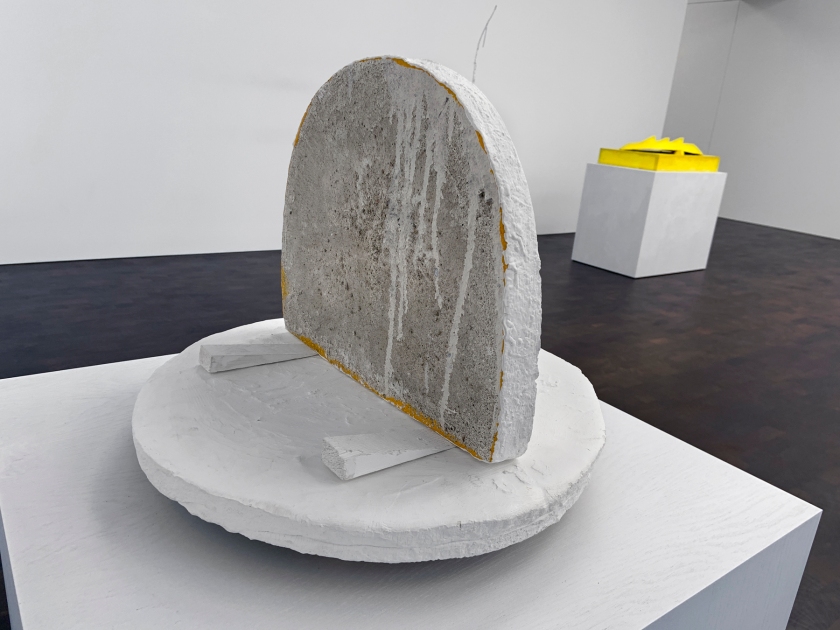
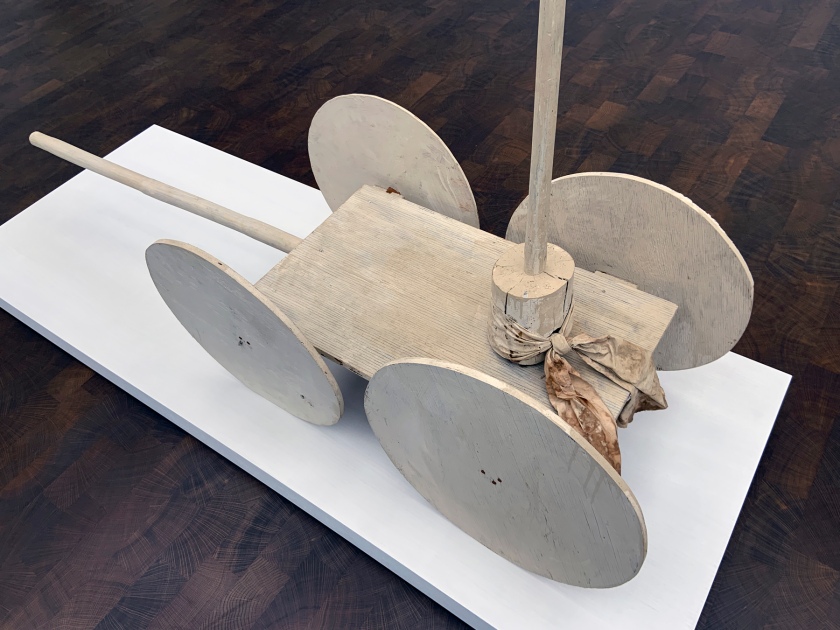
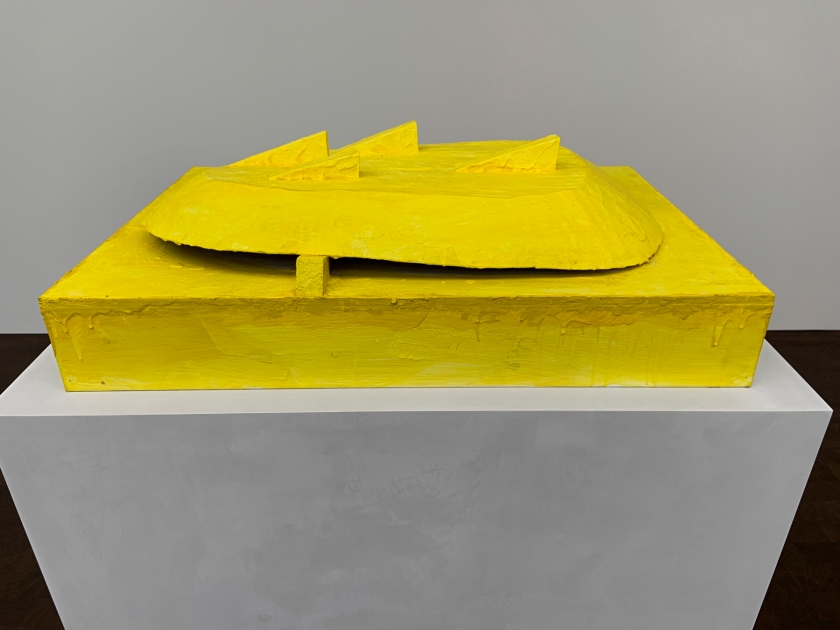



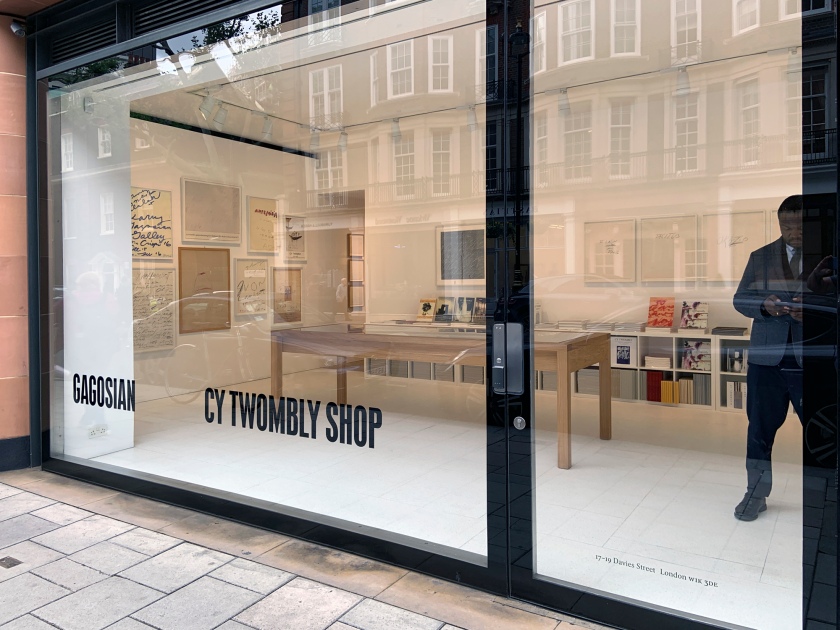
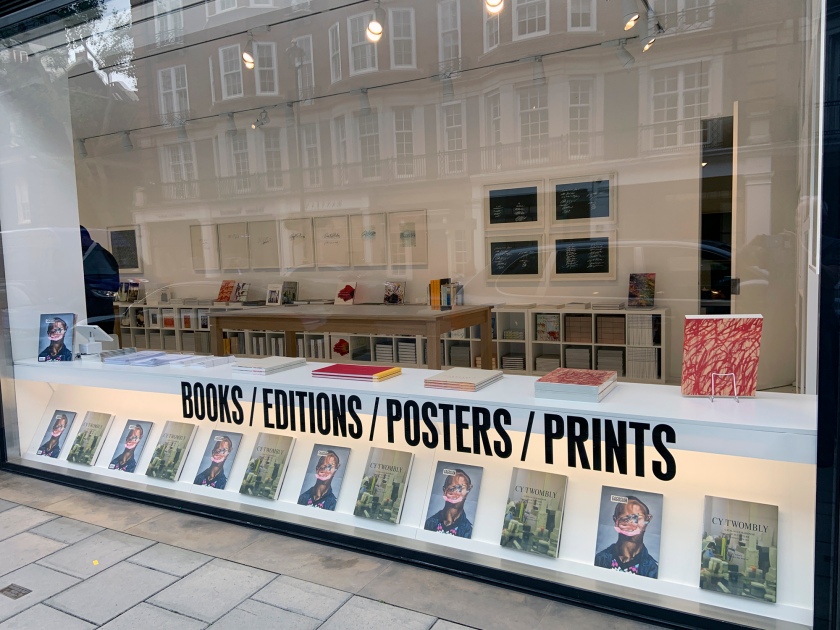

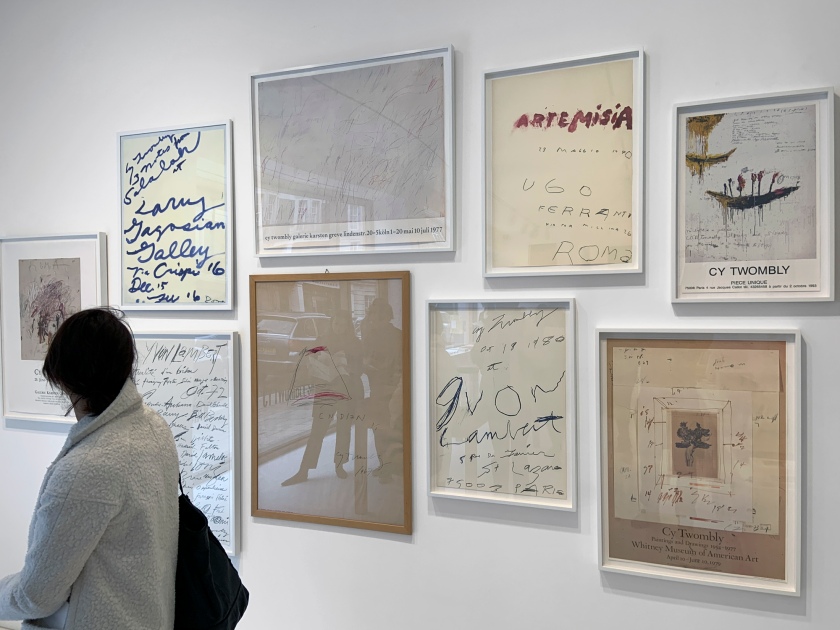



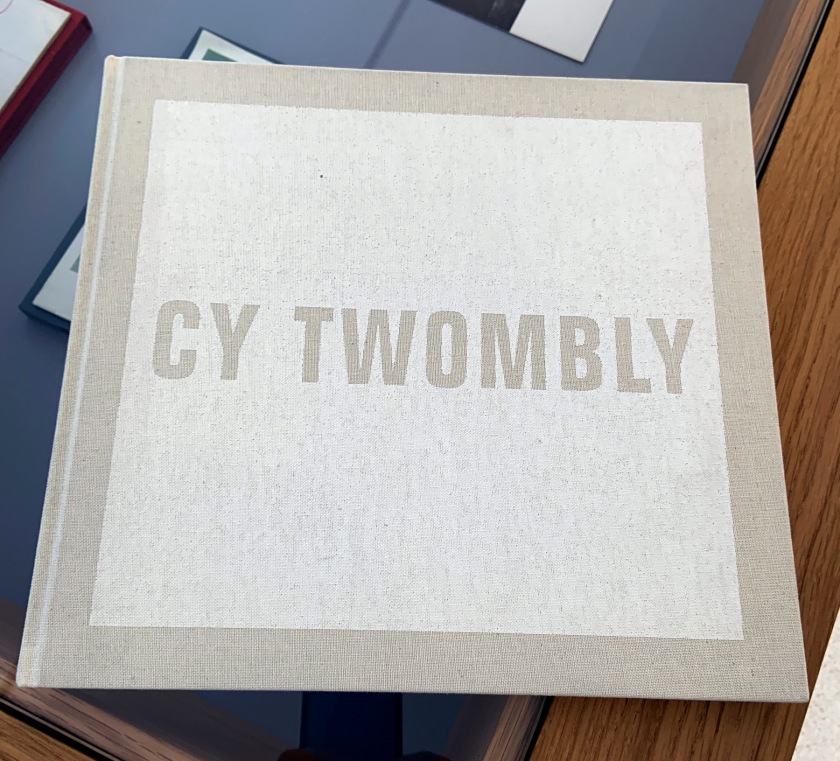
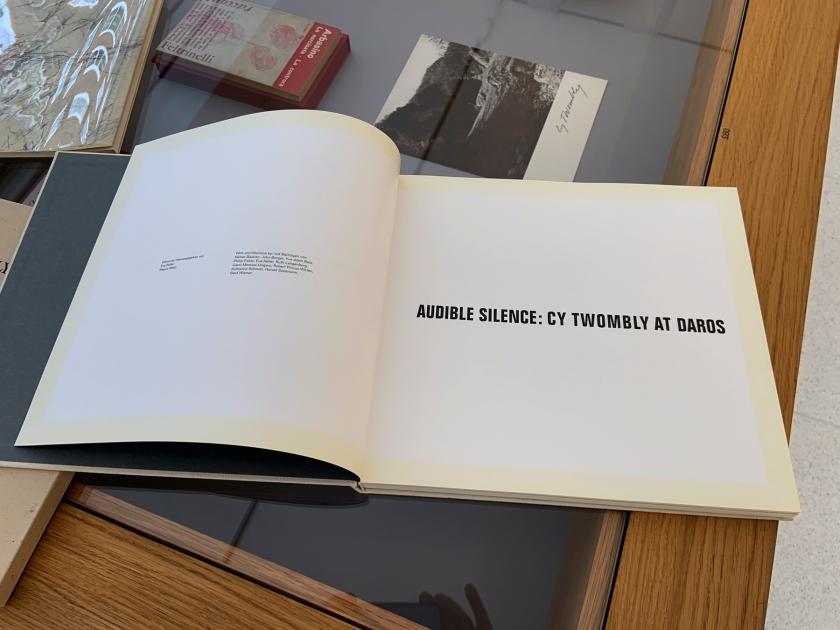







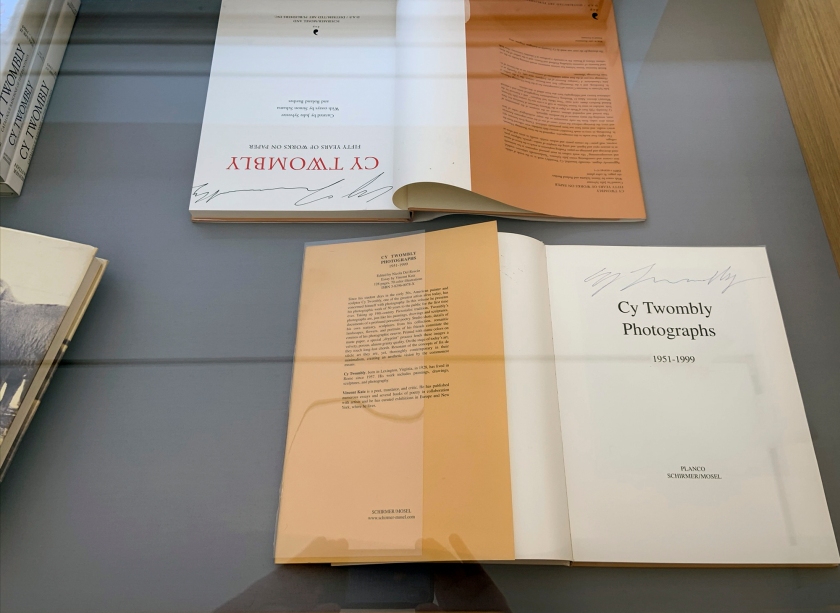
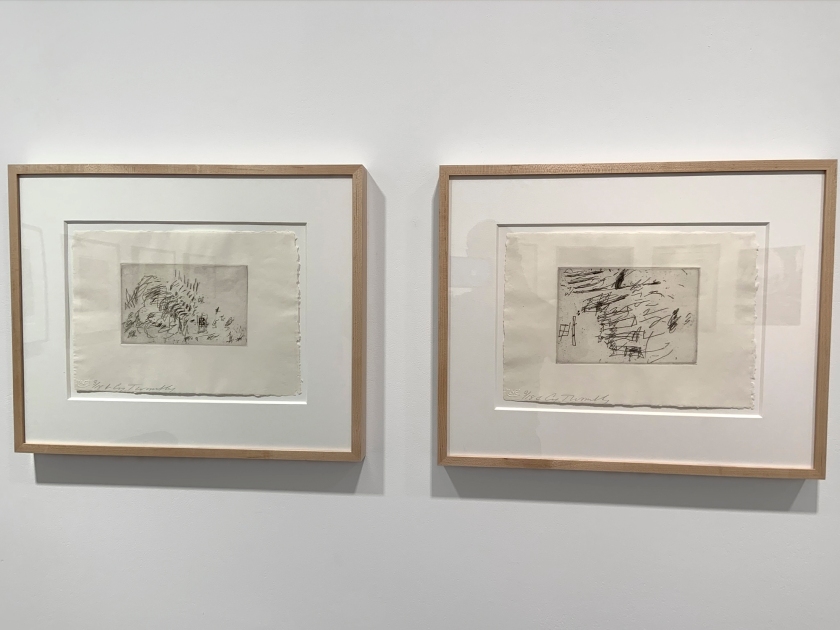




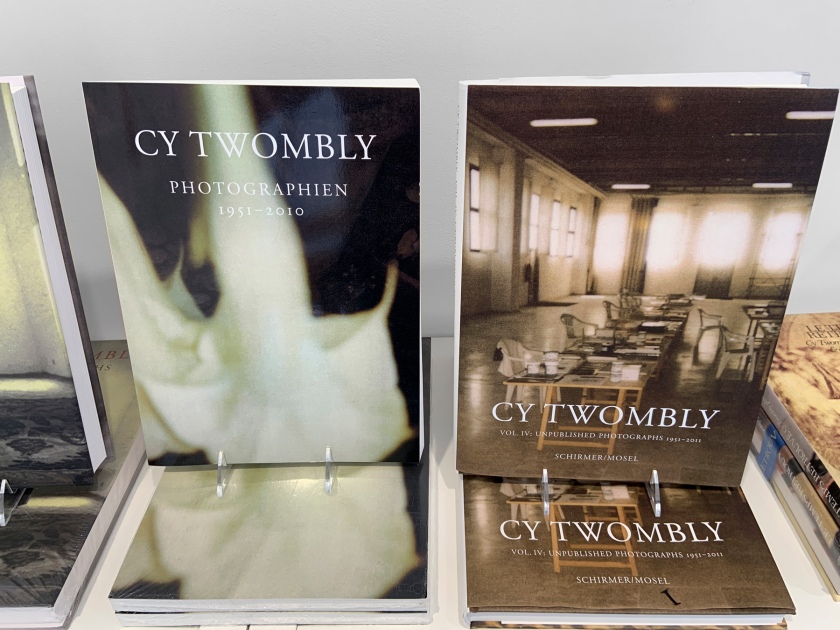

You must be logged in to post a comment.